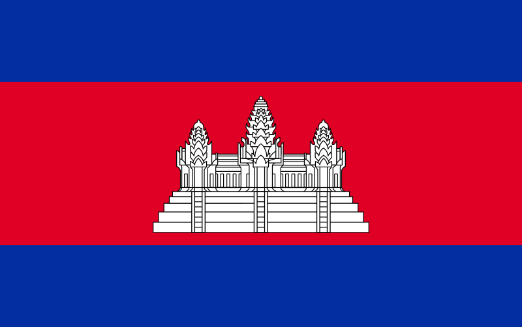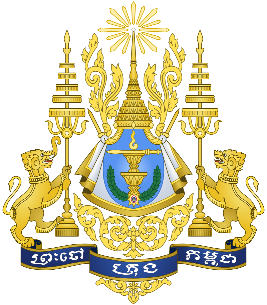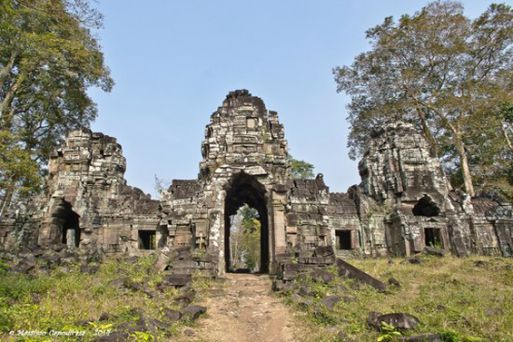Cambodia General Information
Kingdom of Cambodia | |
| |
Motto: "Nation, Religion, King" | |
Capital and largest city | |
Official languages | |
• Total | 181,035 km2 (69,898 sq mi) (88th) |
• Water (%) | 2.5 |
• 2019 census | 15,288,489 (72nd) |
• Density | 86/km2 (222.7/sq mi) (96th) |
Currency | |
Time zone | |
Date format | dd/mm/yyyy |
right | |
Cambodia, officially the Kingdom of Cambodia, is a country located in the southern portion of the Indochina peninsula in Southeast Asia. It is 181,035 square kilometres (69,898 square miles) in area, bordered by Thailand to the northwest, Laos to the northeast, Vietnam to the east and the Gulf of Thailand to the southwest.
The sovereign state of Cambodia has a population of over 15 million. The official religion is Theravada Buddhism, practised by approximately 95 percent of the population. Cambodia's minority groups include Vietnamese, Chinese, Chams and 30 hill tribes. The capital and largest city is Phnom Penh, the political, economic and cultural centre of Cambodia. The kingdom is an elective constitutional monarchy with a monarch, currently Norodom Sihamoni, chosen by the Royal Council of the Throne as head of state. The head of government is the Prime Minister, currently Hun Sen, the longest serving non-royal leader in Southeast Asia, ruling Cambodia since 1985.
Geography
Cambodia has an area of 181,035 square kilometres (69,898 square miles) and lies entirely within the tropics, between latitudes 10° and 15°N, and longitudes 102° and 108°E. It borders Thailand to the north and west, Laos to the northeast, and Vietnam to the east and southeast. It has a 443-kilometre (275-mile) coastline along the Gulf of Thailand.
Cambodia's landscape is characterised by a low-lying central plain that is surrounded by uplands and low mountains and includes the Tonle Sap (Great Lake) and the upper reaches of the Mekong River delta. Extending outward from this central region are transitional plains, thinly forested and rising to elevations of about 650 feet (200 metres) above sea level.
To the north the Cambodian plain abuts a sandstone escarpment, which forms a southward-facing cliff stretching more than 200 miles (320 kilometres) from west to east and rising abruptly above the plain to heights of 600 to 1,800 feet (180–550 metres). This cliff marks the southern limit of the Dângrêk Mountains.
Flowing south through Cambodia's eastern regions is the Mekong River. East of the Mekong the transitional plains gradually merge with the eastern highlands, a region of forested mountains and high plateaus that extend into Laos and Vietnam. In southwestern Cambodia two distinct upland blocks, the Krâvanh Mountains and the Dâmrei Mountains, form another highland region that covers much of the land area between the Tonle Sap and the Gulf of Thailand.
Climate
Cambodia's climate, like that of the rest of Southeast Asia, is dominated by monsoons, which are known as tropical wet and dry because of the distinctly marked seasonal differences.
Cambodia has a temperature range from 21 to 35 °C (70 to 95 °F) and experiences tropical monsoons. Southwest monsoons blow inland bringing moisture-laden winds from the Gulf of Thailand and Indian Ocean from May to October. The northeast monsoon ushers in the dry season, which lasts from November to April. The country experiences the heaviest precipitation from September to October with the driest period occurring from January to February.
According to the International Development Research Center and The United Nations, Cambodia is considered Southeast Asia's most vulnerable country to the effects of climate change, alongside the Philippines. Nearly all provinces in Cambodia are affected by climate change. Rural coastal populations are particularly at risk. Shortages of clean water, extreme flooding, mudslides, higher sea levels and potentially destructive storms are of particular concern, according to the Cambodia Climate Change Alliance.
Cambodia has two distinct seasons. The rainy season, which runs from May to October, can see temperatures drop to 22 °C (72 °F) and is generally accompanied with high humidity. The dry season lasts from November to April when temperatures can rise up to 40 °C (104 °F) around April. Disastrous flooding occurred in 2001 and again in 2002, with some degree of flooding almost every year.
Ecology
Cambodia's biodiversity is largely founded on its seasonal tropical forests, containing some 180 recorded tree species, and riparian ecosystems. There are 212 mammal species, 536 bird species, 240 reptile species, 850 freshwater fish species (Tonle Sap Lake area), and 435 marine fish species recorded by science. Much of this biodiversity is contained around the Tonle Sap Lake and the surrounding biosphere.
The Tonle Sap Biosphere Reserve is a reserve surrounding the Tonle Sap lake. It encompasses the lake and nine provinces: Kampong Thom, Siem Reap, Battambang, Pursat, Kampong Chhnang, Banteay Meanchey, Pailin, Oddar Meanchey and Preah Vihear. In 1997, it was successfully nominated as a UNESCO Biosphere Reserve. Other key habitats include the evergreen and dry Dipterocarp forests of Mondolkiri province, protected by Keo Seima Wildlife Sanctuary, Phnom Prich Wildlife Sanctuary, and Srepok Wildlife Sanctuary, as well as Ratanakiri province, and the Cardamom Mountains ecosystem, including Preah Monivong National Park, Botum-Sakor National Park, and the Phnom Aural Wildlife Sanctuary and Phnom Samkos Wildlife Sanctuary.
The Worldwide Fund for Nature recognises six distinct terrestrial ecoregions in Cambodia – the Cardamom Mountains rain forests, Central Indochina dry forest, Southeast Indochina dry evergreen forest, Southern Annamite Range tropical forest, Tonle Sap freshwater swamp forest, and Tonle Sap-Mekong peat swamp forest.
Administrative divisions
The autonomous municipality (reach thani) and provinces (khaet) of Cambodia are first-level administrative divisions. Cambodia is divided into 25 provinces including the autonomous municipality.
Municipalities and districts are the second-level administrative divisions of Cambodia. The provinces are subdivided into 159 districts and 26 municipalities. The districts and municipalities in turn are further divided into communes (khum) and quarters (sangkat).
|
Tourism
The tourism industry is the country's second-greatest source of hard currency after the textile industry. International visitor arrivals in 2018 topped six million, a ten-fold increase since the beginning of the 21st century.
Besides Phom Penh and Angkor Wat, other tourist destinations include Sihanoukville in the southwest which has several popular beaches and Battambang in the northwest, both of which are popular stops for backpackers who make up a significant portion of visitors to Cambodia. The area around Kampot and Kep including the Bokor Hill Station are also of interest to visitors. Tourism has increased steadily each year in the relatively stable period since the 1993 UNTAC elections.

Most international arrivals in 2018 were Chinese. Tourism receipts exceeded US$4.4 billion in 2018, accounting for almost ten percent of the kingdom's gross national product. The Angkor Wat historical park in Siem Reap Province, the beaches in Sihanoukville, the capital city Phnom Penh, and Cambodia's 150 casinos (up from just 57 in 2014) are the main attractions for foreign tourists.
Cambodia's tourist souvenir industry employs a lot of people around the main places of interest. The quantity of souvenirs that are produced is not sufficient to face the increasing number of tourists and a majority of products sold to the tourists on the markets are imported from China, Thailand, and Vietnam. Some of the locally produced souvenirs include:
- Krama (traditional scarf)
- Ceramics
- Soap, candles, spices
- Wood carvings, lacquerware, silver plate
- Painted bottles containing infused rice wine
Transport
The civil war and neglect severely damaged Cambodia's transport system. With assistance from other countries Cambodia has been upgrading the main highways to international standards and most are vastly improved from 2006. Most main roads are now paved.
Cambodia has two rail lines, totalling about 612 kilometres (380 miles) of single, one-metre (3-foot-3-inch) gauge track. The lines run from the capital to Sihanoukville on the southern coast. Trains are again running to and from the Cambodian capital and popular destinations in the south. After 14 years, regular rail services between the two cities restarted recently – offering a safer option than road for travellers. Trains also run from Phnom Penh to Sisophon (although trains often run only as far as Battambang). As of 1987, only one passenger train per week operated between Phnom Penh and Battambang but a US$141 million project, funded mostly by the Asian Development Bank, has been started to revitalise the languishing rail system that will "(interlink) Cambodia with major industrial and logistics centers in Bangkok and Ho Chi Minh City".
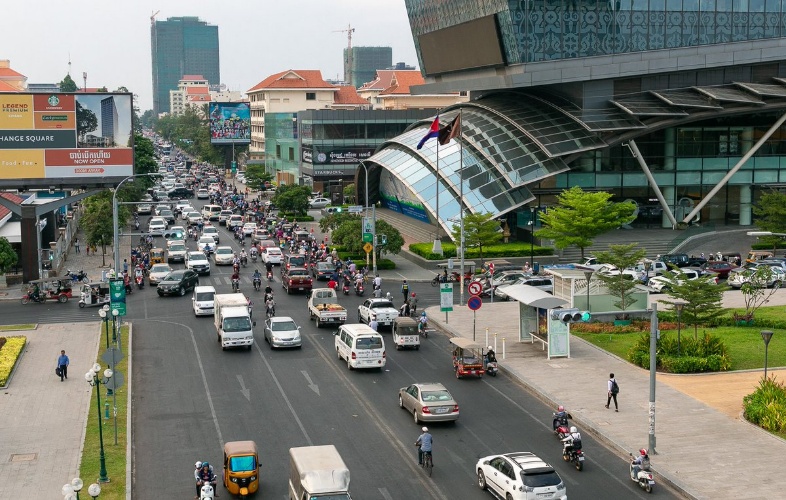
Besides the main inter-provincial traffic artery connecting Phnom Penh with Sihanoukville, resurfacing a former dirt road with concrete / asphalt and bridging five major river crossings have now permanently connected Phnom Penh with Koh Kong, and hence there is now uninterrupted road access to neighbouring Thailand and its road network.
Cambodia's road traffic accident rate is high by world standards. In 2004, the number of road fatalities per 10,000 vehicles was ten times higher in Cambodia than in the developed world, and the number of road deaths had doubled in the preceding three years.
Cambodia's extensive inland waterways were important historically in international trade. The Mekong and the Tonle Sap River, their numerous tributaries, and the Tonle Sap provided avenues of considerable length, including 3,700 kilometres (2,300 miles) navigable all year by craft drawing 0.6 metres (2.0 feet) and another 282 kilometres (175 miles) navigable to craft drawing 1.8 metres (5.9 feet).
Cambodia has two major ports, Phnom Penh and Sihanoukville, and five minor ones. Phnom Penh, at the junction of the Bassac, the Mekong, and the Tonle Sap Rivers, is the only river port capable of receiving 8,000-ton ships during the wet season and 5,000-ton ships during the dry season.
With increasing economic activity has come an increase in automobile use, though motorcycles still predominate. "Cyclo" (as hand-me-down French) or Cycle rickshaws were popular in 1990s but are increasingly replaced by remorques (carriages attached to motorcycles) and rickshaws imported from India. Cyclos are unique to Cambodia in that the cyclist sits behind the passenger seat.
Cambodia has three commercial airports. In 2018, they handled a record of 10 million passengers. Phnom Penh International Airport is the busiest airport in Cambodia. Siem Reap-Angkor International Airport is the second busiest, and serves the most international flights in and out of Cambodia. Sihanouk International Airport, is in the coastal city of Sihanoukville.
Languages
The Khmer language is a member of the Mon–Khmer subfamily of the Austroasiatic language group. French, once the language of government in Indochina, is still spoken by many older Cambodians, and is also the language of instruction in some schools and universities that are funded by the government of France. There is also a French-language newspaper and some TV channels are available in French. Cambodia is a member of La Francophonie. Cambodian French, a remnant of the country's colonial past, is a dialect found in Cambodia and is sometimes used in government, particularly in court. Since 1993, there has been a growing use of English, which has been replacing French as the main foreign language. English is widely taught in several universities and there is also a significant press in that language, while street signs are now bilingual in Khmer and English. Due to this shift, English is now mostly used in Cambodia's international relationships and has replaced French both in Cambodia's stamps, since 2002, and currency.
The Khmer script is derived from the South Indian Pallava script.
Religion
Theravada Buddhism is the official religion of Cambodia, practised by more than 95 percent of the population with an estimated 4,392 monastery temples throughout the country. Cambodian Buddhism is deeply influenced by Hinduism and native animism.
The close interrelationship between spirits and the community, the efficacy of apotropaic and luck-attracting actions and charms, and the possibility of manipulating one's life through contact with spiritual entities such as the "baromey" spirits originates from the native folk religion. Hinduism has left little trace beyond the magical practices of Tantricism and a host of Hindu gods now assimilated into the spirit world (for example, the important neak ta spirit called Yeay Mao is the modern avatar of the Hindu goddess Kali).

Mahayana Buddhism is the religion of the majority of Chinese and Vietnamese in Cambodia. Elements of other religious practices, such as the veneration of folk heroes and ancestors, Confucianism, and Taoism mix with Chinese Buddhism are also practised.
Islam is followed by about 2% of the population and comes in three varieties, two practised by the Cham people and a third by the descendants of Malays, resident in the country for generations. Cambodia's Muslim population is reported to be 80% ethnic Cham.
Culture
Various factors contribute to the Cambodian culture including Theravada Buddhism, Hinduism, French colonialism, Angkorian culture, and modern globalization. The Cambodian Ministry of Culture and Fine Arts is responsible for promoting and developing Cambodian culture. Cambodian culture not only includes the culture of the lowland ethnic majority, but also some 20 culturally distinct hill tribes colloquially known as the Khmer Loeu, a term coined by Norodom Sihanouk to encourage unity between the highlanders and lowlanders.
Rural Cambodians wear a krama scarf which is a unique aspect of Cambodian clothing. The sampeah is a traditional Cambodian greeting or a way of showing respect to others. Khmer culture, as developed and spread by the Khmer empire, has distinctive styles of dance, architecture and sculpture, which have been exchanged with neighbouring Laos and Thailand throughout history. Angkor Wat (Angkor means "city" and Wat "temple") is the best preserved example of Khmer architecture from the Angkorian era along with hundreds of other temples that have been discovered in and around the region.
Traditionally, the Khmer people have a recorded information on Tra leaves. Tra leaf books record legends of the Khmer people, the Ramayana, the origin of Buddhism and other prayer books. They are taken care of by wrapping in cloth to protect from moisture and the climate.
Bon Om Tuuk (Festival of Boat Racing), the annual boat rowing contest, is the most attended Cambodian national festival. Held at the end of the rainy season when the Mekong river begins to sink back to its normal levels allowing the Tonle Sap River to reverse flow, approximately 10% of Cambodia's population attends this event each year to play games, give thanks to the moon, watch fireworks, dine, and attend the boat race in a carnival-type atmosphere.

Popular games include soccer, kicking a sey, which is similar to a footbag, and chess. Based on the classical Indian solar calendar and Theravada Buddhism, the Cambodian New Year is a major holiday that takes place in April. Recent artistic figures include singers Sinn Sisamouth and Ros Serey Sothea (and later Meng Keo Pichenda), who introduced new musical styles to the country.
Every year, Cambodians visit pagodas across the country to mark the 'Festival of the Dead' or Pchum Ben. During the 15-day festival, people offer prayers and food to the spirits of their dead relatives. For most of the Cambodians, it is a time to remember their relatives, who died during 1975-1979 Khmer Rouge regime.
Cuisine
Rice is the staple grain, as in other Southeast Asian countries. Fish from the Mekong and Tonle Sap rivers is also an important part of the diet. The supply of fish and fish products for food and trade as of 2000 was 20 kilograms (44 pounds) per person or 2 ounces per day per person. Some of the fish can be made into prahok for longer storage.
The cuisine of Cambodia contains tropical fruits, soups and noodles. Key ingredients are kaffir lime, lemon grass, garlic, fish sauce, soy sauce, curry, tamarind, ginger, oyster sauce, coconut milk and black pepper. Some delicacies are នំបញ្ចុក (Num Banh chok), អាម៉ុក (Amok), អាពីង (Ah Ping). The country also boasts various distinct local street foods, such as fried spiders.
French influence on Cambodian cuisine includes the Cambodian red curry with toasted baguette bread. The toasted baguette pieces are dipped in the curry and eaten. Cambodian red curry is also eaten with rice and rice vermicelli noodles. Probably the most popular dine out dish, kuy teav, is a pork broth rice noodle soup with fried garlic, scallions, green onions that may also contain various toppings such as beef balls, shrimp, pork liver or lettuce. Kampot pepper is reputed to be the best in the world and accompanies crab at the Kep crab shacks and squid in the restaurants on the Ou Trojak Jet river. The cuisine is relatively unknown to the world compared to that of its neighbours Thailand and Vietnam.
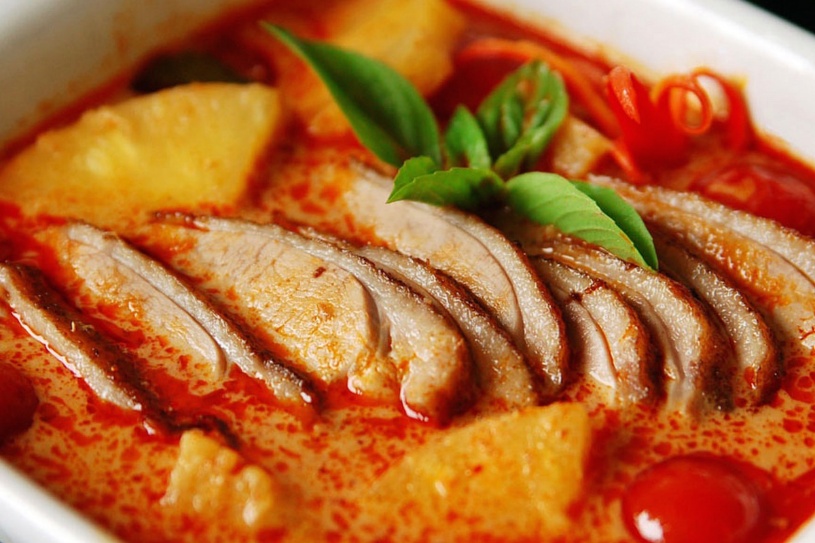
Drinks
Cambodians drink plenty of tea, grown in Mondulkiri Province and around Kirirom. tai krolap is a strong tea, made by putting water and a mass of tea leaves into a small glass, placing a saucer on top, and turning the whole thing upside down to brew. When it's dark enough, the tea is decanted into another cup and plenty of sugar added, but no milk. Lemon tea tai kdao kroich chhmaa, made with Chinese red-dust tea and lemon juice, is refreshing both hot and iced, and is generally served with a hefty dose of sugar.

Regarding coffee, the beans are generally imported from Laos and Vietnam – although domestically produced coffee from Ratanakiri Province and Mondulkiri Province can be found in some places. Beans are traditionally roasted with butter and sugar, plus various other ingredients that might include anything from rum to pork fat, giving the beverage a strange, sometimes faintly chocolatey aroma.
Cambodia has several industrial breweries, located mainly in Sihanoukville Province and Phnom Penh. There are also a growing number of microbreweries in Phnom Penh and Siem Reap. Between 2014 and 2018, the number of craft beer breweries rose from two to nine. As of 2019, there are 12 brewpubs or microbreweries in Cambodia.
Rice wine is a popular alcoholic drink. Its quality varies widely and it is often infused with fruits or medicinal herbs. When prepared with macerated fruits or spices, like the Sombai liqueur, it is called sraa tram (or soaked wine) and has gained more and more popularity with the development of tourism as it is smoother to drink than plain rice wine.



